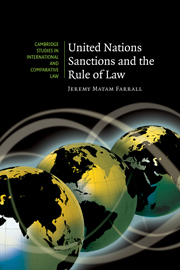Book contents
- Frontmatter
- Contents
- Extended Table of Contents
- Preface
- Abbreviations
- Part I Setting the scene
- Part II The evolution of the UN sanctions framework
- 3 From Aegina to Abyssinia: a prehistory of UN sanctions
- 4 Sanctions under the UN Charter
- Part III UN sanctions in practice
- Part IV Strengthening the rule of law
- Appendix 1 Summary of policy recommendations
- Appendix 2 Summaries of UN sanctions regimes
- Appendix 3 Tables
- Bibliography
- Index
- Cambridge Studies in International and Comparative Law
4 - Sanctions under the UN Charter
Published online by Cambridge University Press: 26 June 2009
- Frontmatter
- Contents
- Extended Table of Contents
- Preface
- Abbreviations
- Part I Setting the scene
- Part II The evolution of the UN sanctions framework
- 3 From Aegina to Abyssinia: a prehistory of UN sanctions
- 4 Sanctions under the UN Charter
- Part III UN sanctions in practice
- Part IV Strengthening the rule of law
- Appendix 1 Summary of policy recommendations
- Appendix 2 Summaries of UN sanctions regimes
- Appendix 3 Tables
- Bibliography
- Index
- Cambridge Studies in International and Comparative Law
Summary
The United Nations was born in the final months of the Second World War, when delegates from around the globe gathered in San Francisco to create an international organisation which would ‘save subsequent generations from the scourge of war’. The founders of the UN were motivated by a desire to avoid repeating the failures of the League of Nations. Their objective was to create an international organisation which would not stand idly by in the face of threats to international peace and security.
A fresh approach to collective security
The UN founders sought to incorporate in the United Nations Charter features designed to ensure not just the participation of as wide a collection of states as possible, but also the active engagement of the most powerful states. The participation of the great powers of the time – the United States of America, the Soviet Union, the United Kingdom, China and France – was secured by granting them permanent membership on the Security Council. Along with permanent membership came the power of the veto, ensuring that the permanent five would never be subjected to collective security action. In order to attract the participation of lesser states, the UN founders drew together a range of idealistic purposes and principles that aimed to reassure smaller states that the UN would protect them where the League could not.
- Type
- Chapter
- Information
- United Nations Sanctions and the Rule of Law , pp. 58 - 78Publisher: Cambridge University PressPrint publication year: 2007



